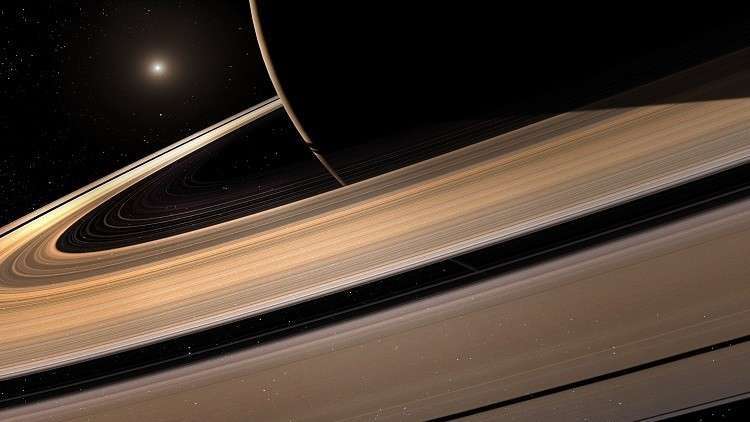لقطات نادرة لـ "ابتلاع القمر" لكوكب زحل تاريخ النشر: 06.04.2019 | 04:00 GMT | الفضاء
Gettyimages.ru
MARK GARLICK/SP
لقطات نادرة لـ"ابتلاع القمر" لكوكب زحل تابعوا RT على
يشهد العام 2019، منذ بدايته، أحداثا فلكية مثيرة، من بينها مرور القمر أمام كوكب زحل، ثاني أكبر كوكب في نظامنا الشمسي.
وحصل المصور الفلكي، كوري شميتز، الذي يتخذ من جنوب إفريقيا مقرا له، على واحدة من أفضل اللقطات خلال "ابتلاع" القمر لكوكب زحل، في 31 مارس الماضي.
ولم يكن ذلك أمرا سهلا، حيث بدأ عمله قبل شروق الشمس عندما مر القمر المضاء بنسبة 40% أمام الكوكب الحلقي، وانتهى هذا الحدث بعد شروق الشمس، عندما تحولت السماء إلى اللون الأزرق منخفض التباين.
ويقول شميتز عبر حسابه الشخصي على إنستغرام: "يا له من مشهد، أنا أحب الأحداث الفلكية: فهي تضخ الدم في عروقي".
View this post on Instagram
RAW VIDEO WARNING. Watch with sound, it's more fun. . It's also way better on YouTube. (link in profile) . A post to help describe why we need to create composite images using the raw #astrophotography data we acquire for events like the #occultation of #Saturn by the #moon on 2019-03-29. . Raw is rad, composites look nice. . Swipe for a single unaltered raw video frame taken from a green channel video I collected. . Saturn is there, but the video is exposed to not blow out any moon features. Saturn is barely above the noise floor. . Swipe again and look closely inside the red ellipse, that's the difference in brightness. . Swipe again to see same exact raw video frame, with an overall gamma correction (midtones shift) on the entire frame to bring up Saturn while somewhat overexposing the moon. . Again, swipe to see the same exact raw video frame, but with the midtones boost masked to only include Saturn, and leave the moon exposure alone. . Using separate video acquisitions for the red, green, and blue channels, and two separate exposure settings, one for the moon and one for Saturn, we can process the moon and Saturn separately using six total video acquisition runs. Then we put them back together into one image. . Another reason that a composite is required in this case is because as the video acquisitions are made to build up a color image, the two bodies are actively moving independently of each other. Apparent motion of the moon through the frame is faster than Saturn! . Also note that things like the pretty comet images you've seen are also done the same way: separate processing, and recombination in post: composites. . The data is true, the final image is a representation of reality as accurate as the photographer can make it. That's our duty. . Finslly,swipe again to see the final image. The chosen placement of Saturn for the final image is at the beginning of the first video acquisition run. . I dislike having to make a composite, but when things move quickly like this, and you shoot with a monochrome camera and filter wheel, it's necessary. . #astrophotography #astronomy #youresa #nightsky #deepsky #space #planet #lunar #astro_photo #deepspace
A post shared by Cory Schmitz (@theastroshake) on Apr 1, 2019 at 11:40am PDT
View this post on Instagram
What a view this was! I Love these astro events. They get my blood pumping. This is my first crack at processing the data I collected during the #occultation of #Saturn by the #moon, just before sunrise on Friday morning, viewable from South Africa. About three minutes after this, Saturn disappeared from view, hidden by the moon. For almost two hours. . It's a composite image made from 2 sets of RGB data, one for the moon and one for Saturn. . I used a @zwoasi 290MM monochrome camera and a motorized filter wheel, the imaging telescope was a 12" RC. . I used FireCapture and some custom scripts to automate the process as much as possible. . I had to make a composite image because the moon is far greater than the brightness of Saturn. To get a decent image I needed to use much higher gain for Saturn, which would blow out the moon exposure. So the moon and Saturn were processed separately and combined. . I'm dedicating this image to our late dogchild, Holly, who passed away the night before this event. Usually she would be keeping me company in the backyard when I image, and she was missed this time. . More to come. Hope you enjoy it! . #astrophotography @photographingspace #nightsky #deepsky #deepspace #planet #lunar #space #conjunction #occultation #nightphotography #youresa #space #youresa #space #moon_of_the_day #thisissouthafrica #SouthAfrica
A post shared by Cory Schmitz (@theastroshake) on Mar 30, 2019 at 6:38am PDT
واستخدم شميتز كاميرا "ASI290mm" أحادية اللون، مزودة بعجلة تصفية آلية مثبتة على تلسكوب "Ritchey-Chrétien" بمقاس 12 بوصة، اعتمادا على تقنية "Fire Capture"، لتصوير الفيديو الخاص بزحل وهو يخرج من وراء القمر في النهار، على الرغم من صعوبة التصوير في الوقت الباكر من الصباح.
ويظهر زحل على بعد 1.5 مليار كلم، أصغر بنحو 47 مرة من القمر، واستغرق القمر ما يزيد قليلا عن دقيقة لتغطية زحل وحلقاته.
وبعد 2019، لن "يبتلع" القمر زحل مرة أخرى، حتى السادس من أبريل عام 2024، قبل يومين فقط من الكسوف الكلي المقبل للشمس الذي ستشهده أمريكا الشمالية.
المصدر: ساينس ألرت
تابعوا RT على





